Services on Demand
Journal
Article
Indicators
-
 Cited by SciELO
Cited by SciELO -
 Access statistics
Access statistics
Related links
-
 Cited by Google
Cited by Google -
 Similars in
SciELO
Similars in
SciELO -
 Similars in Google
Similars in Google
Share
Revista Colombiana de Ciencias Químico - Farmacéuticas
Print version ISSN 0034-7418On-line version ISSN 1909-6356
Rev. colomb. cienc. quim. farm. vol.40 no.1 Bogotá Jan./June 2011
Artículo de Investigación científica
Volumetric properties of glycerol + water mixtures at several temperatures and correlation with the Jouyban-Acree model
Propiedades volumétricas de mezclas glicerol + agua a varias temperaturas y correlación con el modelo Jouyban-Acree
Diana M. Cristancho 1 , Daniel R. Delgado 1 , Fleming Martínez 1 , Mohammad A. Abolghassemi Fakhree 2 , Abolghasem Jouyban 3
1 Grupo de Investigaciones Farmacéutico-Fisicoquímicas, Departamento de Farmacia, Facultad de Ciencias, Universidad Nacional de Colombia, A.A. 14490, Bogotá, D.C., Colombia.
* Correspondence: E-mail: fmartinezr@unal.edu.co.
2 Liver and Gastrointestinal Diseases Research Center, Tabriz University of Medical Sciences, Tabriz, Iran.
3 Drug Applied Research Center and Faculty of Pharmacy, Tabriz University of Medical Sciences, Tabriz, Iran.
Received: April 18, 2011 Accepted: May 24, 2011
SUMMARY
Excess molar volumes and partial molar volumes were investigated from density values of the literature for glycerol + water mixtures at temperatures from (288.15 to 303.15) K. Excess molar volumes were fitted by Redlich-Kister equation and compared with values of literature for other similar systems. The system exhibits negative excess volumes probably due to increased interactions like hydrogen bonding and/or large differences in molar volumes of components. The effe ct of temperature on different volumetric properties studied is also analyzed. Besides, the volume thermal expansion coefficients are also calculated founding values from 2.51 x 10 -4 K -1 for water to 7.24 x 10 -4 K -1 for glycerol at 298.15 K. The Jouyban-Acree model was used for density and molar volume correlations of the studied mixtures at different temperatures. The mean relative deviations between experimental and calculated data were 0.19 ± 0.11 % and 0.32 ± 0.25 %, respectively for density and molar volume data.
Key words: glycerol, water, binary liquid mixtures, density, excess volume, Jouyban- Acree model.
RESUMEN
En este trabajo se calculan los volúmenes molares de exceso a partir de valores de densidad tomados de la literatura para el sistema glicerol + agua en todo el intervalo de composición a temperaturas entre 278,15 y 313,15 K. Los volúmenes molares de exceso se modelaron de acuerdo a la ecuación de Redlich-Kister usando polinomios regulares de segundo grado y se compararon con otros presentados en la literatura para otros sistemas. El sistema estudiado presenta volúmenes de exceso altamente negativos (hasta -0,40 cm 3 mol -1 ) probablemente debido a las fuertes interacciones por unión de hidrógeno entre las moléculas de los dos compuestos y a la gran diferencia en los volúmenes molares de los dos componentes puros. También se analizó el efecto de la temperatura sobre las diferentes propiedades volumétricas estudiadas. Así mismo se calcularon los coeficientes térmicos de expansión volumétrica encontrado valores desde 2,51 x 10 -4 K -1 para el agua pura hasta 4,38 x 10 -4 K -1 para el glicerol puro a 298,15 K. Finalmente se usó el modelo Jouyban-Acree para correlacionar la densidad y el volumen molar de las diferentes mezclas encontrando desviaciones medias relativas de 0,19 ± 0,11 % y 0,32 ± 0,25 % para densidades y volúmenes molares respectivamente.
Palabras clave: glicerol, agua, mezclas líquidas binarias, volúmenes de exceso, modelo de Jouyban-Acree.
INTRODUCCIÓN
Water-cosolvent mixtures have been used widely in pharmacy in order to increase the solubility of drugs poorly soluble in water during the design of homogeneous pharmaceutical dosage forms, such as syrups and elixirs, among others (1, 2). 1,2-Propanediol and ethanol are the cosolvents most used in design nowadays, especially those intended for elaboration of peroral and parenteral medications (3). Thus, several examples of pharmaceutical formulations using these cosolvents have been presented by Rubino (1). In similar way, glycerol has also been used in pharmaceutical and cosmetic sciences as cosolvent and evaporation regulator in several formulations (4, 5).
The mixtures obtained using these cosolvents and water show highly non-ideal behavior due to increased interactions between unlike molecules and large differences in molar volumes of pure components, which leads to non-additive volumes on mixing (6, 7). For this reason it is necessary to characterize the volumetric behavior of these binary mixtures as a function of temperature in order to extend the physicochemical information available for liquid mixtures used in pharmacy and cosmetics. This information is useful to understand the intermolecular interactions present in liquid pharmaceutical systems (8). Also, data related to density of solute free mixture of solvents might be useful in prediction of the density of pharmaceutical substances in mixture of solvents (9).
In this report, the excess molar volumes and the partial molar volumes of the binary system of glycerol + water at various temperatures in addition to other volumetric properties were calculated according to modified procedures widely exposed in the literature (10-12). This report is a continuation of those presented previously about some volumetric properties of ethanol + water (13), 1,2-propanediol + water mixtures (14), and glycerol formal + water (15).
DENSITIES AND CALCULATIONS
Density values of glycerol + water mixtures were taken from the literature (16). These values were determined in composition varying in 0.01 in mass fraction of glycerol to report 99 binary mixtures at temperatures of 288.15, 293.15, 298.15, and 303.15 K.
RESULTS AND DISCUSSION
In Table 1 the composition of glycerol + water mixtures, in mass percent and mole fraction, in addition to density values at several temperatures are presented (16). It is important to note that there are some other reports in the literature about density values of this binary system (17-20), but the more comprehensive and systematic is the one studied here. Moreover, some differences are found among the reported values. For this reason, the values compiled in the Ref. (16) are processed in this work. In all cases the density decreases almost linearly as the temperature increases except for water which is not linear. In the same way, density of mixtures increases almost linearly with the glycerol proportion.
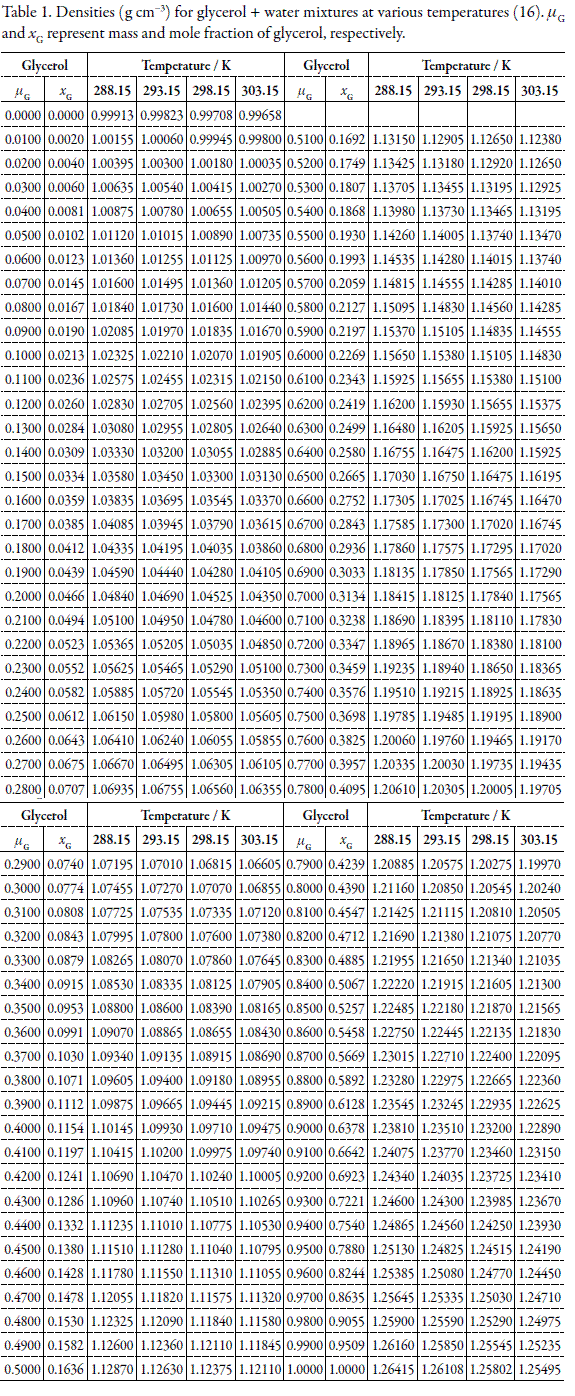
Molar volumes and excess molar volumes
Table 2 summarizes the molar volumes (V 0 ) for the binary mixtures at all temperatures. V 0 values were calculated from Eq. 1.
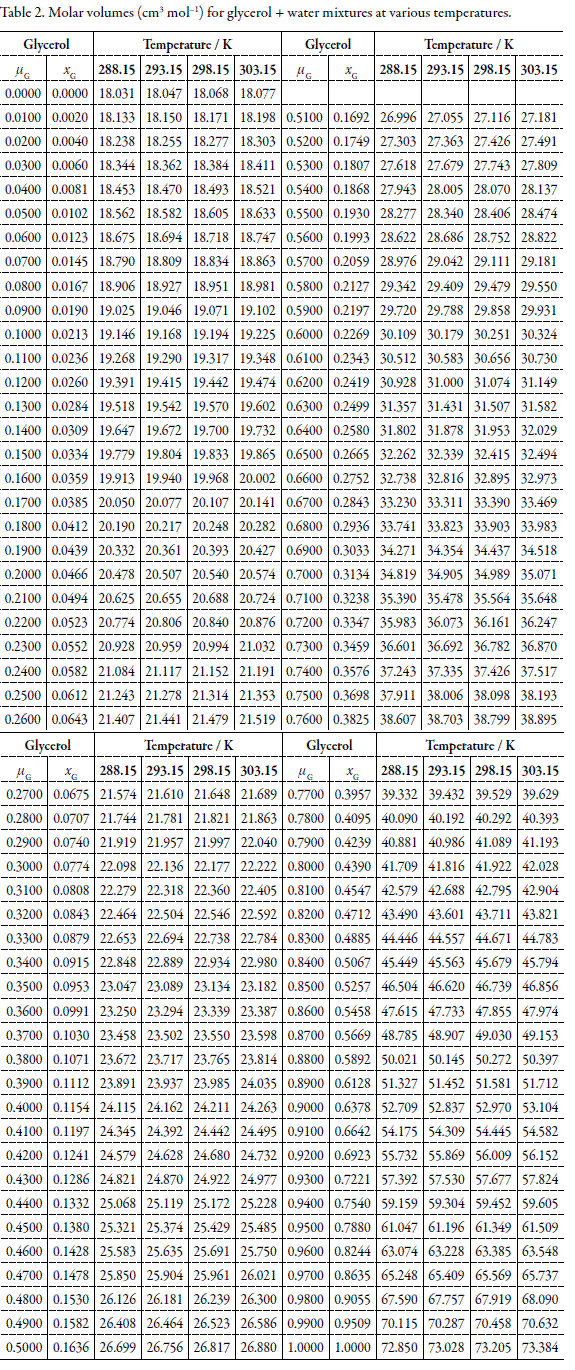

where, x 1 and x 2 are the mole fractions and M 1 and M 2 are the molar masses, for both components respectively, and p is the mixture density.
On the other hand, the excess volumes calculated from Eq. 2 (where, p 1 and p2 are the densities of pure components) at all temperatures studied are presented in Table 3. This behavior is shown graphically in Figure 1 at all temperatures.

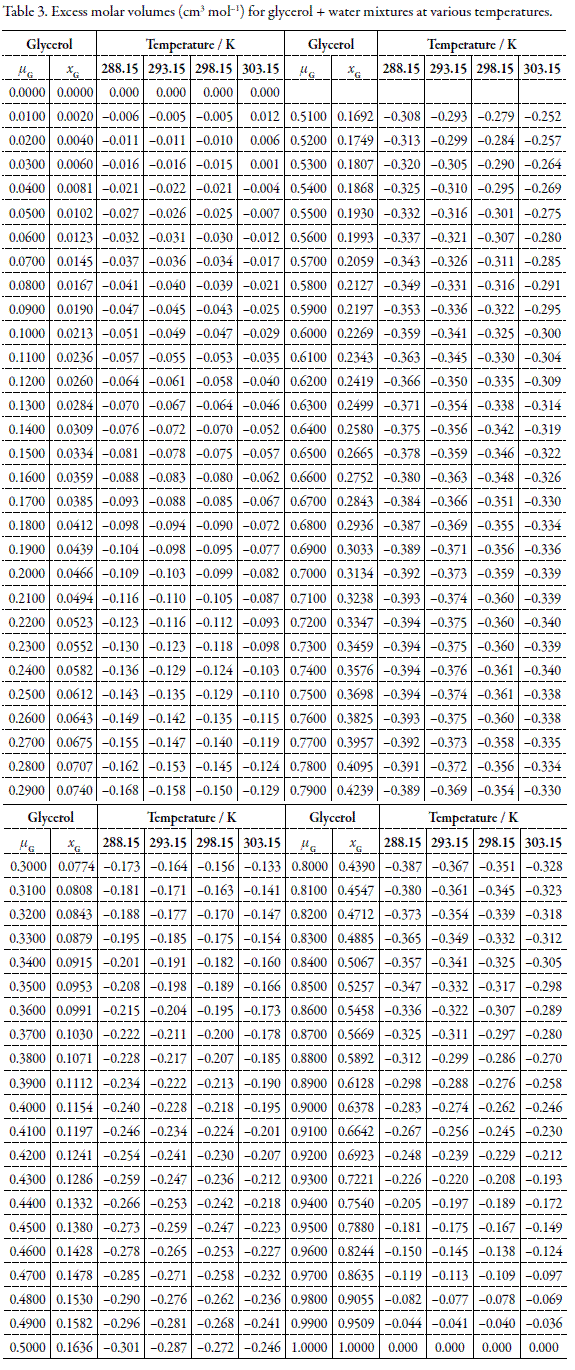
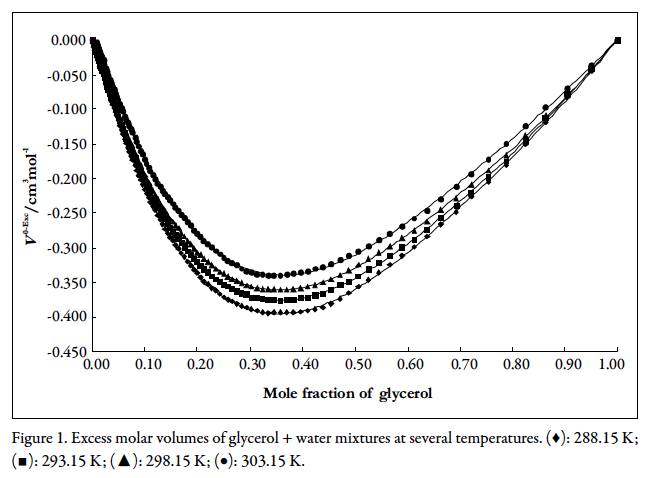
Analogous to the behavior obtained in other investigations (13-15), in almost all cases the excess volumes are largely negative (especially around 0.38 in mole fraction of glycerol, where it is near to -0.38 cm 3 mol -1 ) indicating contraction in volume. As mentioned before (13-15), according to Fort and Moore (21), a negative excess volume is an indication of strong heteromolecular interactions in the liquid mixtures and is attributed to charge transfer, dipole-dipole, dipole-induced dipole interactions, and hydrogen bonding between the unlike components, while a positive sign indicates a weak interaction and is attributed to dispersion forces (London interactions) which are likely to be operative in all cases.
In the evaluated system, where the hydrogen bonding predominates, the contraction in volume has been interpreted basically in qualitative terms considering the following events, first: expansion due to depolymerization of water by addition of glycerol; second: contraction due to free volume difference of unlike molecules; and third: contraction due to hydrogen bond formation between glycerol and water through -OH-- -OH bonding (21).
Thus, the large negative values of V 0-Exc over the free volume contribution indicate the presence of strong specific interactions with predominance of formation of hydrogen bonds between glycerol and water over the rupture of hydrogen bonding in water- water.
The excess molar volumes becomes less negative as the temperature is raised indicating volume expansion which points out the decrease in the interactions between glycerol and water molecules with increase in temperature.
With the aim to compare the effect of the mixtures polarity on the maximum excess molar volumes, Table 4 shows the values obtained for ethanol + water (13), 1,2-pro-panediol + water (14), and glycerol + water. Mixtures compositions are expressed in mass, mole, and volume fractions, respectively. Volume fractions were calculated by assuming additive behavior according to f = V cosolv /(V cosolv + V water) with V equal to volume o each component (22). Dielectric constant (relative dielectric permittivity) and Hildebrand solubility parameter of mixtures have been chosen as polarity indexes (23, 24). These properties have been calculated by considering additive behavior when the mixtures compositions are expressed in volume fractions (2), except for the dielectric constant of ethanol + water and glycerol + water mixtures, where a model developed by Jouyban et al. was employed (25). It is remarkable that maximum negative excess molar volumes are linearly correlated with both polarity indexes as can be seen in Figures 2 and 3 in which the greater the absolute excess volume is, the lower the polarity of cosolvent is. Besides, better correlation was found with solubility parameter.
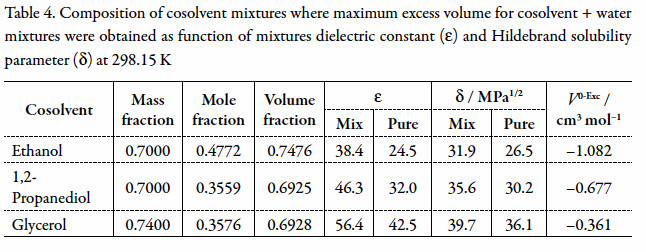
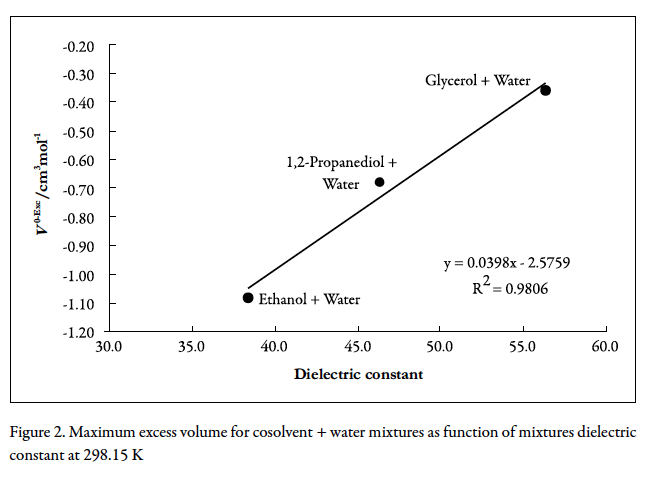
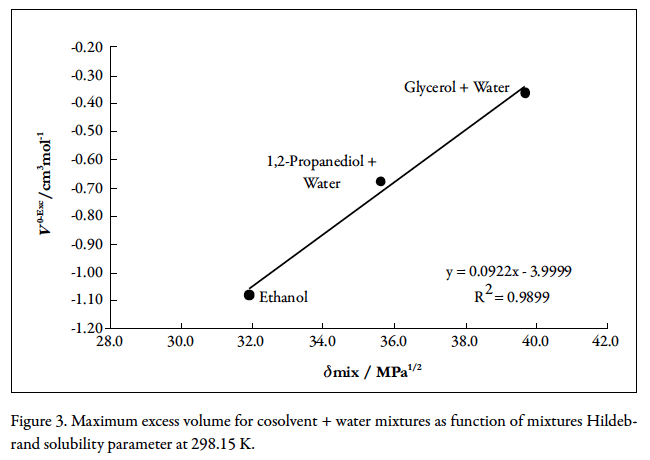
Redlich-Kister equation
Redlich and Kister (26) introduced in 1948 the general form of Eq. 3 to facilitate the representation of thermodynamic properties and the classification of solutions in multicomponent systems, especially those important in petroleum chemistry. The Redlich-Kister equation has been used in recent decades for manipulating several kinds of physicochemical values of mixtures such as: excess volumes, excess viscosities, solubilities in cosolvent mixtures, among others.

In the analysis of excess volume data, Eq. 3 was used in the form of second degree poly-nomial equations using least square analyses, and therefore, obtaining three coefficients as presented in Eq. 4. Polynomials of second and third degrees are the most widely used in this case again, based on their relevant statistic parameters such as determination coefficients and standard deviations

The Redlich-Kister parameters for glycerol + water mixtures at all temperatures studied are presented in Table 5 in addition to determination coefficient s and standard deviations calculated according to Eq. 5 (where D is the number of compositions studied and N is the number of terms used in the regression, that is 99 and 3 respectively in this case). Eq. 5 has been widely used in the literature (8, 10-15). Figure 4 shows the Redlich-Kister equation applied to glycerol + water excess molar volume data at all temperatures studied.

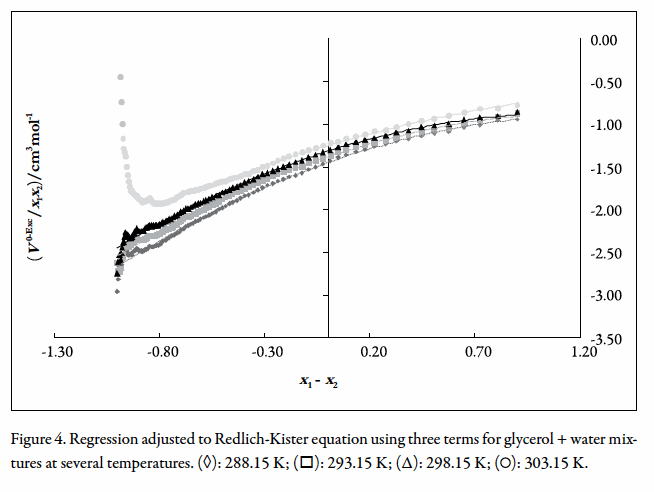
The variation coefficients are greater than 0.99 which indicate that the obtained regular polynomials regressions describe adequately the excess volumes, because the standard deviations are similar to those presented in the literature for other mixtures (8, 10-15). It is important to note that the different behavior observed at 303.15 K could be due to the low negative excess molar volumes and even positive values obtained in water-rich mixtures. On the other hand, Ï values obtained for glycerol + water mixtures were in general lower than those obtained for ethanol + water (13) and 1,2-propanediol + water (14) although third degree regular polynomials were used to describe these systems.
Volume thermal expansion
On the other hand, in pharmaceutical and chemical pre-formulation studies, it is very important to predict the variation of physicochemical properties related to pharmaceutical dosage forms, with respect to temperature changes; especially those properties which affect the concentration of active ingredients in the formulations developed. For this reason, the volume thermal expansion coefficients (α) were calculated by means of Eq. 6 (27) using the variation of molar volumes with temperature (Table 2).

Table 6 summarizes the (θV 0 /θT) and α values for pure solvents and binary mixtures varying in mole fractions near to 0.05, whereas Figure 5 shows the volume thermal expansion coefficients at 298.15 K. For all mixtures and pure solvents, linear model were used, in which obtained determination coefficients are greater than 0.999, except for water where quadratic model has been obtained. The α values varied from 2.51 x 10 -4 K -1 in water up to 4.86 x 10 -4 K -1 in pure glycerol. From 0 to 0.20 in mole fraction of glycerol the α values increase readily. In a first approach this fact would be explained in terms of water-structure loosing by addition of glycerol. It should be kept in mind that over 0.3 in mole fraction of glycerol the most contributing component in mass to all mixtures is glycerol, which is also the less polar solvent in these mixtures (2, 3).
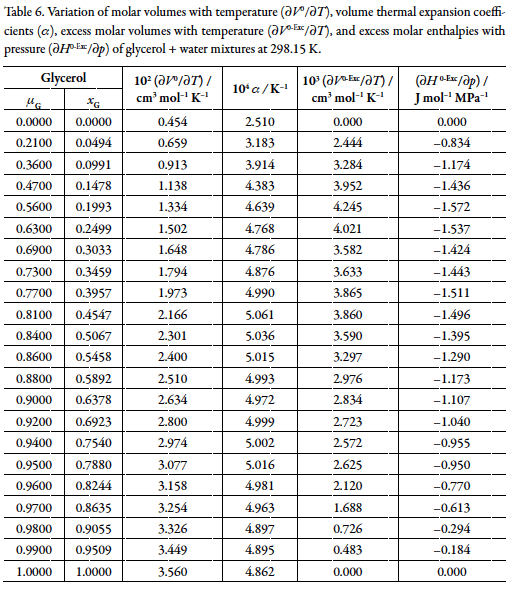
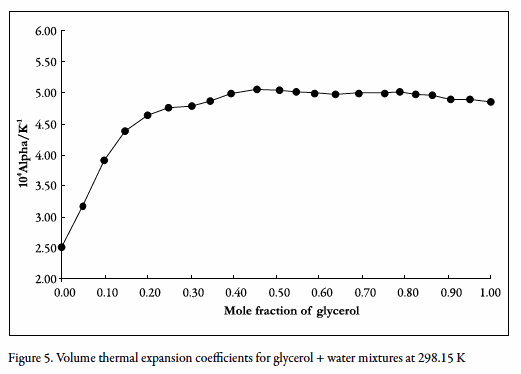
To correlate volume thermal expansion coefficients with solvent polarity Figures 6 and 7 show the variation of this property with the dielectric constant and Hildebrand solubility parameter of each pure solvent for ethanol, 1,2-propanediol and glycerol, respectively. It is clear that inverse relation is found between α and polarity indexes because bigger molar expansivities correspond to lesser polar cosolvents.
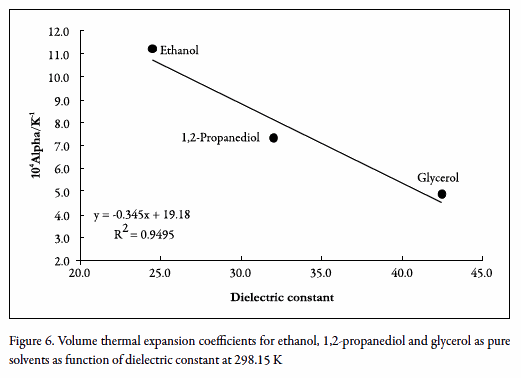
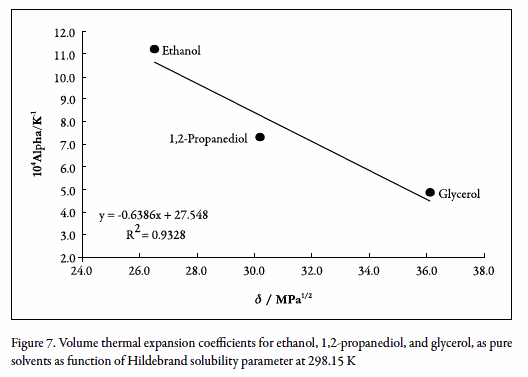
Variation of excess molar volume with temperature
An additional and important treatment is the evaluation of change of the excess molar volumes with temperature (θϑV 0-Exc /θT). Table 6 and Figure 8 show this property at 298.15 K (this value is constant over the entire temperature interval considered, that is, from 288.15 K to 303.15 K), which was obtained considering parabolic behavior of (θV 0-Exc /θT) in almost all mixtures studied, except the last two. In almost all cases the determination coefficient values obtained were greater than 0.98. From Figure 8 it follows that there is only a tendency according to composition, that is, this property is always positive, which reflects the fact that excess volume decreases with increasing temperature. This result could be due to weakening of hydrogen-bonding as the temperature increases which could lead to solvent structure loosing, and thus, leading to more ideal mixing behavior.
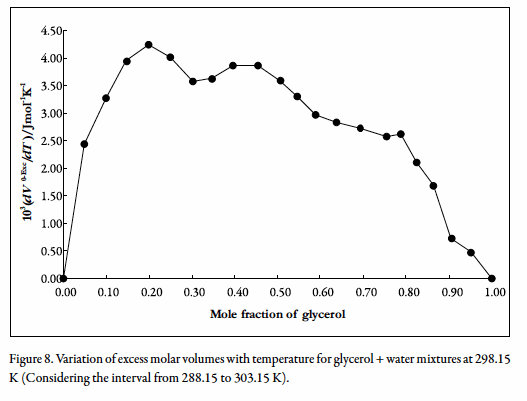
Variation of excess molar enthalpy with pressure
From the excess molar volumes presented in Table 3, the change of the excess molar enthalpies with pressure according to Eq. 7 was calculated (27):

Table 6 and Figure 9 show (θH 0-Exc /θp) values at 298.15 K. It follows that this property is negative in all compositions, indicating an increase in the excess molar enthalpy as the pressure is increased. Unfortunately, there is not available experimental data in the literature about this property for this system. Although, Batov et al. (28) made a calorimetric study on heat of mixing of glycerol and water founding excess molar enthalpies negative in all the mixtures studied at 298.15 K (from 298.15 K to 338.15 K).
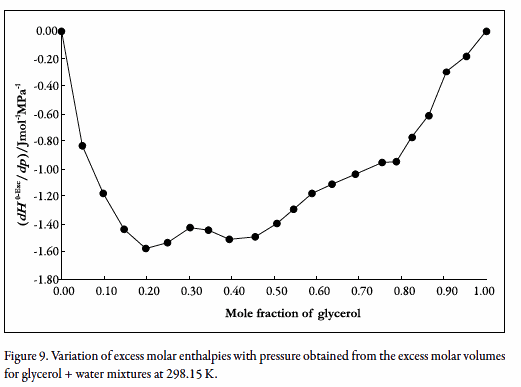
On the other hand, some other theoretical and experimental techniques have been used to investigate the nanoscopic structure of these mixtures. In particular, molecular dynamics simulation and infra-red spectra analysis have been developed on glycerol + water mixtures to determine the hydrogen bond patterns of glycerol and its mixtures with water (29). This study was performed to verify that the ability of glycerol/water mixtures to inhibit ice crystallization is linked to the concentration of glycerol and the hydrogen bonding patterns formed by these solutions (29).
Data correlation using the Jouyban-Acree model
For binary data analyses, the Jouyban-Acree model was used to correlate the experi- mental density data of mixed solvents (15, 30):

where Pm,T, P1,T, P2,T are densities of mixed solvents, cosolvent, and water at different temperatures (T), respectively. The x 1, x 2 are mole fractions of cosolvent and water, respectively. The methodology to fin d the J i terms was described in previous works (15, 30). The following equation was obtained for density correlation of mixtures of glycerol and water at different temperatures:

The main advantage of the Jouyban-Acree model over Redlich-Kister equation is that it includes the effects of temperature in the model constants and provides the possibility of density predictions at other temperatures using interpolation technique, whereas the constants of the Redlich-Kister equation is only valid for one temperature. As noted in Introduction, Eq. 9 could be used to predict the density of saturated solutions of a drug dissolved in glycerol + water mixtures employing the experimental densities of saturated solutions in glycerol and water as described in more details for other systems in a previous paper (9). The calculated density values using Eq. 8 against the experimental values are presented in Figure 10.
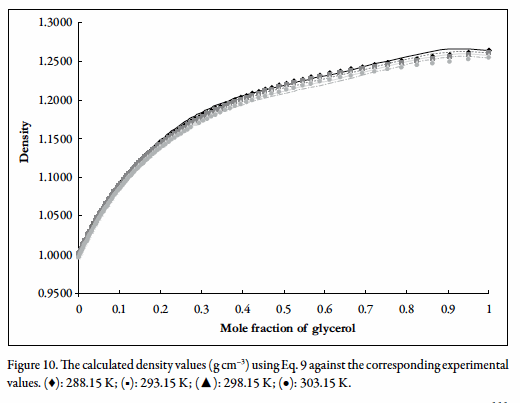
where V 0m,T, V 01,T, V 02,T are molar volumes of mixed solvents, cosolvent, and water at different temperatures. The model fits very well to the experimental data. This is the second report of application of the Jouyban-Acree model for representing the molar volume data of solvent mixtures at various temperatures.
The mean relative deviation (MRD) between experimental and calculated data was calculated using:

and were 0.19 ± 0.11 % and 0.32 ± 0.25 % for Eq. 9 and Eq. 10, respectively. The N in Eq. 11 is the number of data points in the data set.
CONCLUSIONS
This report expands widely the experimental volumetric information about the glycerol + water cosolvent system available nowadays because it includes the behavior at four temperatures commonly found in technological conditions. As mentioned earlier, this information could be employed in several engineering processes and for the theoretical understanding of the behavior of cosolvent mixtures used in the chemical and pharmaceutical industries. In general terms, based on our results and those presented in the literature for other experimental and theoretical procedures, it can be concluded that glycerol + water mixtures clearly show non ideal behavior. Nevertheless, the observed deviations are lower than those observed earlier for aqueous mixtures containing ethanol and 1,2-propanediol as cosolvents. These observations demonstrate clearly that it is necessary to characterize systematically this important binary system in order to have complete experimental information about the physical and chemical properties useful in the understanding of liquid pharmaceutical systems.
REFERENCES
1. J.T. Rubino, Cosolvents and Cosolvency, in "Encyclopedia of Pharmaceutical Technology", Vol. 3, edited by J. Swarbrick, J.C. Boylan, Marcel Dekker, Inc., New York, 1988. pp. 375-98. [ Links ]
2. S.H. Yalkowsky, "Solubility and Solubilization in Aqueous Media", American Chemical Society and Oxford University Press, New York, 1999, pp. 180-235. [ Links ]
3. D.C. Pérez, C.C. Guevara, C.A. Cárdenas, J.A. Pinzón, H.J. Barbosa, F. Martínez, Solubility and displacement volumes of acetaminophen in binary mixtures formed by propylene glycol, ethanol, and water at 25.0 °C (in Spanish), Rev. Colomb. Cienc. Quím. Farm., 32, 116 (2003). [ Links ]
4. W.J. Reilly, Pharmaceutical necessities, in: "Remington: The Science and Practice of Pharmacy", 21 st ed., edited by A. Gennaro, Lippincott Williams & Wilkins, Philadelphia, 2005, pp. 1081-1082. [ Links ]
5. A.O. Barel, M. Paye, H.I. Maibach, "Handbook of Cosmetic Science and Technology", Marcel Dekker, Inc., New York, 2001. [ Links ]
6. R. Battino, Volume changes on mixing for binary mixtures of liquids, Chem. Rev., 71, 5 (1971). [ Links ]
7. U.R. Kapadi, D.G. Hundiwale, N.B. Patil, M.K. Lande and P.R. Patil, Studies of viscosity and excess molar volume of binary mixtures of propane-1,2 diol with water at various temperatures, Fluid Phase Equilibria, 192, 63 (2001). [ Links ]
8. S.J. Rodríguez, D.M. Cristancho, P.C. Neita, E.F. Vargas, F. Martínez, Volumetric properties of the octyl methoxycinnamate + ethyl acetate solvent system at several temperatures, Phys. Chem. Liq., 48, 638 (2010). [ Links ]
9. Sh. Soltanpour, A. Jouyban, Solubility of acetaminophen and ibuprofen in binary and ternary mixtures of polyethylene glycol 600, ethanol and water, Chem. Pharm. Bull. (Tokyo), 58, 219 (2010). [ Links ]
10. J.A. Salas, J.L. Zurita, M. Katz, Excess molar volumes and excess viscosities of the 1-chlorobutane + pentane + dimethoxyethane ternary system at 298.15 K, J. Argent. Chem. Soc., 90, 61 (2002). [ Links ]
11. R.D. Peralta, R. Infante, G. Cortez, R.R. Ramírez, J. Wisniak, Densities and excess volumes of binary mixtures of 1,4-dioxane with either ethyl acrylate, or butyl acrylate, or methyl methacrylate, or styrene at T = 298.15 K, J. Chem. Thermodynamics, 35, 239 (2003). [ Links ]
12. J.M. Resa, C. González, J.M. Goenaga, M. Iglesias, Temperature dependence of excess molar volumes of ethanol + water + ethyl acetate, J. Solution Chem., 33, 169 (2004). [ Links ]
13. J. Jiménez, J. Manrique, F. Martínez, Effect of temperature on some volumetric properties for ethanol + water mixtures, Rev. Colomb. Cienc. Quím. Farm., 33, 145 (2004). [ Links ]
14. J. Jiménez, F. Martínez, Study of some volumetric properties of 1,2-propanediol + water mixtures at several temperatures, Rev. Colomb. Cienc. Quím. Farm., 34, 46 (2005). [ Links ]
15. D.R. Delgado, F. Martínez, M.A.A. Fakhree, A. Jouyban, Volumetric properties of the glycerol formal + water cosolvent system and correlation with the Jouyban-Acree model, Phys. Chem. Liq., DOI: 10.1080/00319104.2011.584311. [ Links ]
16. DOW Chemical Company, Density of Glycerin-Water Solutions, Table, accessed on April, 2011.URL: http://msdssearch.dow.com/PublishedLiteratureDOWCOM/dh_0032/0901b80380032282.pdf?filepath=glycerine/pdfs/noreg/115-00656.pdf&fromPage=GetDoc [ Links ]
17. D.R. Lide, "CRC Handbook of Chemistry and Physics", 84 th ed., CRC Press LLC, Boca Raton, 2003. [ Links ]
18. L. Xu, X. Hu, R. Lin, Volumetric properties of glycerol with N,N-dimethylform- amide and with water at 25 and 35 °C, J. Solution Chem., 32, 363 (2003). [ Links ]
19. I.I. Adamenko, L.A. Bulavin, V. Ilyin, S.A. Zelinsky, K.O. Moroz, Anomalous behavior of glycerol-;water solutions, J. Mol. Liquids, 127, 90 (2006). [ Links ]
20. U.S. Vural, V. Muradoglu, S. Vural, Excess molar volumes, and refractive index of binary mixtures of glycerol + methanol and glycerol + water at 298.15 K and 303.15 K, Bull. Chem. Soc. Ethiop., 25, 111 (2011). [ Links ]
21. R.T. Fort, W.R. Moore, Viscosities of binary liquid mixtures, Trans. Farad. Soc., 62, 1112 (1966). [ Links ]
22. K.A. Connors, "Thermodynamics of Pharmaceutical Systems: An Introduction for Students of Pharmacy", Wiley-Interscience, Hoboken NJ, 2002. pp. 61-66. [ Links ]
23. A. Martin, P. Bustamante, A.H.C. Chun, "Physical Chemical Principles in the Pharmaceutical Sciences", 4 th ed., Lea & Febiger, Philadelphia, 1993. [ Links ]
24. A. Barton, "Handbook of Solubility Parameters and Other Cohesion Parameters", 2 nd ed., CRC Press, New York, 1991, pp. 101-103. [ Links ]
25. A. Jouyban, S. Soltanpour, H.-K. Chan, A simple relationship between dielectric constant of mixed solvents with solvent composition and temperature, Int. J. Pharm., 269, 353 (2004). [ Links ]
26. O. Redlich, A.T. Kister, Algebraic representation of thermodynamic properties and the classification of solutions, Ind. Eng. Chem., 40, 345 (1948). [ Links ]
27. J.B. Ott, J. Boerio-Goates, "Chemical Thermodynamics: Advanced Applications", Academic Press, London, 2000, pp 271-291. [ Links ]
28. D.V. Batov, A.M. Zaichikov, V.P. Slyusar, V.P. Korolev, Enthalpies of mixing and state of components in aqueous-organic mixtures with nets of hydrogen bonds, Russ. J. Gen. Chem., 71, 1208 (2001). [ Links ]
29. J.L. Dashnau, N.V. Nucci, K.A. Sharp, J.M. Vanderkooi, Hydrogen bonding and the cryoprotective properties of glycerol/water mixtures, J. Phys. Chem. B, 110, 13670 (2006). [ Links ]
30. A. Jouyban, A. Fathi-Azarbayjani, M. Khoubnasabjafari, W.E. Acree Jr., Mathematical representation of the density of liquid mixtures at various temperatures using Jouyban-Acree model, Indian J. Chem. A, 44, 1553 (2005). [ Links ]














